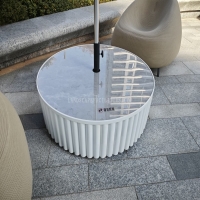Welcome to the website for landscape facilities products and knowledge.
How does the design of a landscape round trash can influence its resistance to cracking from freeze-thaw cycles?
The design of a landscape round trash can plays a critical role in its ability to withstand freeze-thaw cycles without cracking. One of the primary factors is material selection. High-density polyethylene (HDPE) or reinforced polymers are often used due to their flexibility and resistance to temperature fluctuations. These materials can expand and contract without developing stress fractures.
Another key aspect is the structural design. A round shape distributes stress more evenly compared to angular designs, reducing the likelihood of cracks forming at weak points. Additionally, thicker walls and reinforced bases provide extra durability against the expansion of freezing water inside the can.
Ventilation and drainage features are also essential. Small drainage holes at the bottom prevent water accumulation, minimizing the risk of ice formation that could exert pressure on the material. Proper ventilation reduces condensation, further protecting the trash can from moisture-related damage.
Lastly, UV-resistant coatings or additives can enhance the material's longevity by preventing brittleness caused by prolonged sun exposure, which could otherwise make the trash can more susceptible to cracking during temperature swings.
By combining these design elements, a landscape round trash can achieves superior resistance to freeze-thaw cycles, ensuring reliable performance in harsh outdoor conditions.
Related search:

Recommendation
Round metal tube border design table with tempered glass or granite countertop on the top.